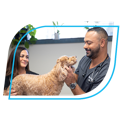Are Probiotics the Next Best Cat Hairball Remedy?
Jump to Section

Cat parents: we all know the familiar sound of a cat hacking up a hairball. It's not pleasant to witness and is even more uncomfortable for our feline friends. Is there a natural hairball remedy for cats that can reduce the frequency and severity of hairballs? Inquiring cat parents want to know!
With Hairball Awareness Day just days away, what better time to dive into the fascinating facts of cat hairballs? In this blog post, we'll explore the question of whether or not probiotics can help cats get rid of hairballs, and more tips to try at home!
Can you use probiotics for cats with hairballs?
- Probiotics can help to increase the number of good bacteria in the gut, which can aid in digestion and reduce inflammation in the digestive tract––potentially making hairballs easier to pass for your cat.
- Probiotics can also help to break down hair and other fibers that can contribute to the formation of hairballs.
- Probiotics support digestive health, but can also have benefits for immunity, mood, and more. By supporting your pet’s overall health and well-being, you could be reducing their risk of over-grooming due to stress and other illnesses.
Other home remedies for cat hairballs
In addition to using a probiotic for cats, there are several other natural hairball remedies for cats that you can try. Petroleum jelly is a common cat hairball remedy that many pet parents swear by. Simply apply a small amount of petroleum jelly to your cat's paw or nose, and they will lick it off, helping to lubricate their digestive tract and reduce the likelihood of hairballs.
Another remedy–that your cat will really enjoy–is canned sardines or other oily fish. Adding oily fish to a cat's diet can help to lubricate their digestive tract. A well-lubricated digestive tract can have benefits for smoother passing of not just hairballs but bowel movements, too!
Grooming your cat regularly with a pet grooming brush can also be helpful in reducing hairballs. Regular brushing can help to remove loose hair before your cat has a chance to ingest it, reducing the amount of hair that ends up in their digestive system. Finally, making sure your cat stays hydrated is also important, as dehydration can contribute to hairball formation.
PET TIP
Did you know that cats aren’t the only animals who cough up hairballs? Rabbits, ferrets, cattle, deer, and even black bears get hairballs, too!
What causes hairballs?
Hairballs happen when cats groom themselves and swallow hair, which can then accumulate in their digestive tract. Small bumps on the tongue–the ones that give cat tongues their ‘sandpaper’ texture–grab loose hairs when a cat grooms itself. These tiny bumps (called papillae) are slanted backward towards the throat, which is why hair ends up being digested by cats.
While most cats will experience hairballs from time to time, certain factors can increase their likelihood. These include:
Long hair
Indoor lifestyle
Old age
Stress

What do cat hairballs look like?
Cat hairballs can vary in appearance, depending on their size and composition. They’re typically sausage-shaped with a matted appearance, and can range in size from a few millimeters to an inch or so.
When a cat is about to cough up a hairball, they may make retching or gagging sounds, and the hairball itself could be covered in a slimy substance.
Having trouble deciphering whether the substance on the carper is a cat hairball, vomit, or something else? When in doubt, snap a picture and share it with your veterinarian to be sure.

Which cats get hairballs?
While all cats are susceptible to hairballs, there are certain types that may be more prone to developing them. These include long-haired cats, indoor cats, older cats, and stressed or anxious cats.
If you notice that your cat’s experiencing frequent or severe hairballs, the best place to start is always with your veterinarian! They can help you rule out any underlying health issues, and explore the best home or clinical treatment options for you and your cat.
This blog exists to provide general information and education about veterinary health and related subjects. The information and other content provided in this blog, website, or in any linked materials is not intended as and should not be considered, or used as a substitute for, medical advice, diagnosis, or treatment. We cannot diagnose conditions, provide second opinions, or make specific treatment recommendations through this blog or website.
If you suspect that your pet has a medical concern, you should consult with your veterinary health care provider or seek other professional medical treatment immediately. Never disregard professional medical advice or delay in seeking it because of something that you have read on this blog, website, or in any linked materials.
Join the Pack!

Sign up for exclusive deals, curated pet tips from veterinarians, and product launches!
Pet Parents are Also Reading...
November, 2022
Related Articles























